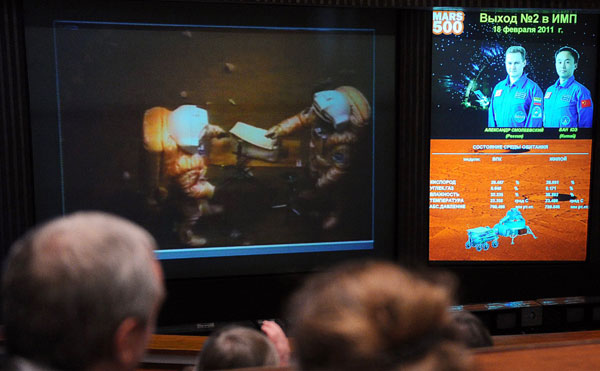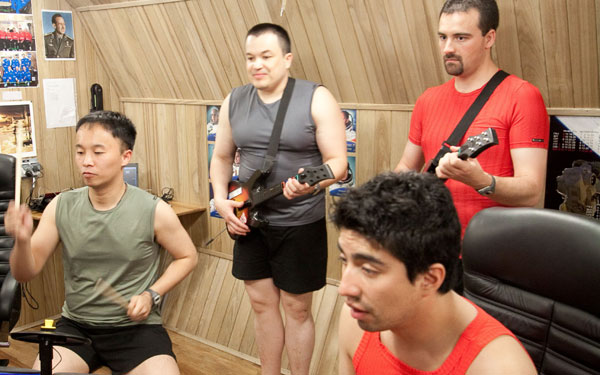2011flash
Taikonaut simulates landing on Red Planet
Updated: 2011-02-19 09:31
By Hu Yongqi (China Daily)
BEIJING - After 267 days in a locked, windowless steel capsule, Wang Yue, the only Chinese crewmember of the Mars 500 mission, performed his first simulated landing on the Red Planet on Friday.
|
 Journalists watch Wang Yue (left), 28, an instructor at the China Astronaut Research and Training Center, "walk" on the Red Planet on Friday with Russia's Alexander Smoleyevsky during the Mars-500 experiment at the Korolev Space Mission Control Center outside Moscow. [Photo/Agencies] |
|
 It's not all hard work as Wang Yue plays the drums with backing from the band of "astronauts" in this file photo by Xinhua taken on June 12, 2010. |
The landing lasted for about an hour, starting at 1 pm Moscow time. Medical tests showed Wang was "very well" before the exercise, said Bai Yanqiang, who is heading up China's part in the project.
| ||||
In a white spacesuit weighing 32 kilograms, Wang and his Russian shipmate Alexander Smoleyevsky stepped out of the capsule to conduct mock scientific experiments. Wang was scheduled to use the remote-controlled mechanical arm of a Mars rover to take "rock and soil samples" from the sand-covered ground, but he did it manually when the machine broke down.
The all-male crew includes three Russians, Smoleyevsky, Alexey Sitev and Sukhrob Kamolov, Frenchman Romain Charles, Italian Diego Urbina and Wang from China. They entered a network of modules at a Moscow space research center last June to simulate a 520-day flight to Mars. Scientists have been observing how they cope with the constricted, isolated conditions.
The flags of Russia, China and the European Space Agency were planted on the Red Planet after Smoleyevsky and Urbina performed the first mock landing on Feb 14.
In addition to landing operations, crewmembers also made use of an operating platform, a helmet display system, joysticks and monitors, according to Bai. By using these devices, participants can simulate the search for water on the Martian surface and provide remote m
edical aid for injured crewmembers. They will be able to deal with simulated dust storms and other bad weather.
Participants also drove manned rovers with virtual technology software on the "Martian" surface to simulate an evacuation in the event of a meteor shower.
The next mock landing will be on Feb 22, one day before the lander will leave "Mars" and start its return to Earth. It is scheduled to arrive in November.
Xin Dingding in Beijing and AP contributed to this story.
Specials

Spring Festival
The Spring Festival is the most important traditional festival for family reunions.

Top 10
A summary of the major events both inside and outside China.

A role model
Alimjan Halik had been selected as the "Cyberspace Personality Who Moved the Hearts of the Chinese in 2010".


